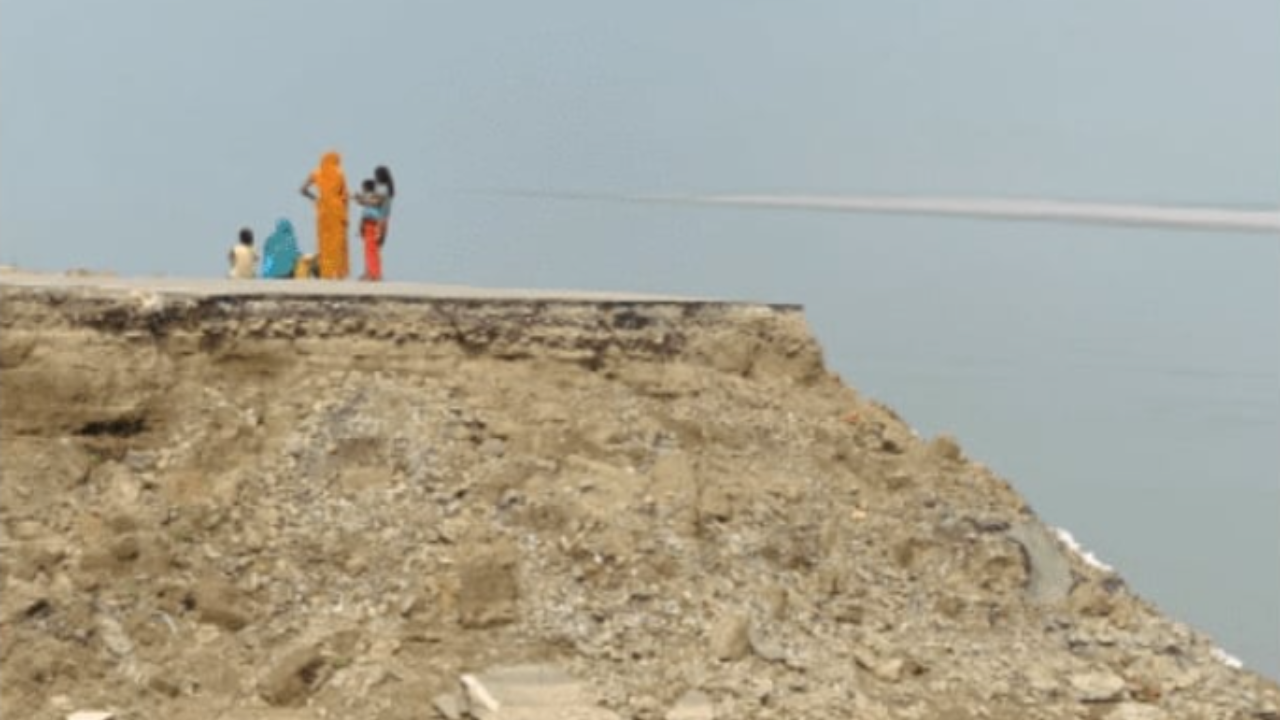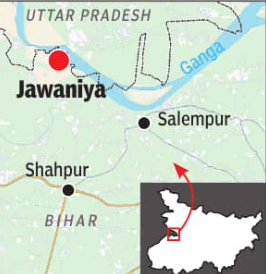JAWANIYA (BHOJPUR): Rivers give in abundance. But when swollen with fury, they plunder without mercy. This July, the primeval Ganga took everything that belonged to this riverine village in Bhojpur district of Bihar. It became a land grabber, a livelihood snatcher, a home wrecker and, as one gathers after visiting the habitation, a destroyer of dreams.Parts of Jawaniya now look like a lunatic’s playground — houses carved into pieces like cakes, dead bamboo forests and roads that abruptly end before a rivercreated precipice. About 200 homes, two water tanks, two schools and three temples were swallowed in the swirling waters. Over 300 bighas (1 bigha equals to 0.6 acres) of fecund land were gnawed away. Ward No. 5, and much of Ward No. 4, don’t exist anymore. Substantial parts of the village are now deemed unsafe. Jawaniya is comatose.

A Void For HomeEighty-one-year-old Sriram Sahu has lived through many floods, but none like this. “I’d never seen so much water, such strong currents,” he says. Vijay Thakur, who lost 90% of his land, affirms. “Flood doesn’t scare us,” he says. “Soil erosion (katav) does. We had never imagined it would be this bad.” Ward member Ashish Pandey says the only mercy was that nobody died. “We managed to empty the homes in advance,” he says.The river has left a gaping hole in every Jawaniya heart. The loss of homes isn’t just financial. The sudden physical erasure of a place — where everyone lived, loved and grew up — has filled most villagers with an unbearable melancholy. “Ghar nahi raha, bas ab ghar ka moh bhar hai (There’s no home anymore, just a yearning for it),” says Sandeep Chaudhary of the EBC Bind community. Like most who lost their homes, his family has moved to a bandh (embankment), over a kilometre away. But, like a restless vagabond, he returns to the riverbank every now and then.The embankment is a narrow strip; barely wide enough to set up a tent. To walk to the other side, you gingerly trudge up the slope. The camps are made of canvas and reed. These are survival units where you’ll find sewing machines, gas cylinders, and old trunks kept messily for lack of space. A man sleeps on a charpoy beside a buffalo while a girl pets a rooster on her lap. “I can endure. But my kids haven’t seen hard times. How can they bear all this?,” says a tearyeyed middle-aged woman.In one of the tents, Sandeep’s younger brother, Vijay, is studying mathematics. He is preparing for his Class 12 examinations. They earlier lived in a concrete home with eight rooms. Four of them have fallen into the river, parts of the remaining half hang in the air like a person standing on one leg. Their father, a sharecropper, had toiled all his life to build the house. Scattered school notebooks and a pitch-black hearth tells the story of a hurried evacuation amid a bed of red hibiscus flowers that looks incongruous in these glum surroundings.

The family belongings are stored in four places. Some items are with their married sister, who lives about 20km away; the remaining articles are kept either at a temple, or with a friend. Only the bare necessities are at the embankment. Like some others, the Chaudharys are building a reed hut at some distance from the riverbank. “We haven’t left the village. But the village has left us,” says Sandeep.Weighing ChoicesNeeraj’s father, Mangru, is not at home. He is campaigning for the BJP candidate, Rakesh Ojha. So is Pawan Thakur, a bhumihar by caste, who owned 20 bighas of land and is now homeless, landless and jobless. A group of eight men have travelled on motorbikes to a nearby village, where UP deputy CM and BJP leader Keshav Prasad Maurya is addressing an election meeting.A village of yadavs, brahmins, binds, gonds (tribals) and bhumihars, Jawaniya has about 1,500 voters. The Shahpur assembly seat, of which it is a part, has been mostly held by RJD. Two-time MLA Rahul Tiwary is now aiming for a hat-trick. Both candidates have visited Jawaniya.Sentiments, barring those among the yadavs, seem more inclined towards Ojha, described as a “naya yuva chehra (a new youthful face)”. Locals say that he ran a langar (free food service) during the floods. Among others who provided relief materials was Bhojpuri singer-actor Pawan Singh, who distributed 1,500 tents and 2,000 bamboo poles. Jan Suraaj leader Prashant Kishor spent Diwali with the villagers.Nearby villages such as Karja Bazaar were also flooded in July. The waters have receded. But in Jawaniya, they have left behind a sandy bed. Earlier the land, locals say, was fit for wheat, pulses, millets and sesame. “Now we can only grow watermelons,” says Neeraj.Jawaniya is conjoined with another village, Chakki Naurangia, both on the Bihar-Uttar Pradesh border. Homes and lands in both villages have been lost forever. “The district administration ran a flood relief camp for two and a half months. Every family received a gratuity of Rs 7,000,” says Tanai Sultania, DM, Bhojpur, over the phone. It is also learnt that house compensation has been partially disbursed and the villagers are likely to be settled in Bilauti, about 30km away. But several villagers said they haven’t received the compensation yet.Vijay Ram, a Dalit, from Chakki Naurangia, stands staring at the river. Like many others, he has moved to the relief camp. The melancholy of loss, he says, lingers. “This village is my birthplace — I keep coming back,” he explains. Today, he has brought his wife to the riverbank. She wanted to see their ‘home’. He points about 200 metres away. “That’s where it was,” he tells her. There’s nothing there, only a river now at peace with itself.


